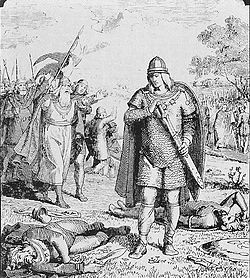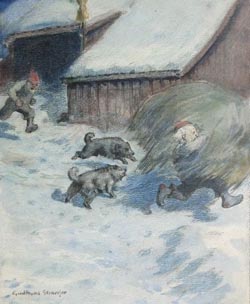Emerstarian folklore
Emerstarian folklore consists of folk tales, legends, songs, music, dancing, recipes, popular beliefs, humor, and traditions communicated by the Emerstarian nation; they often passed on from generation to generation via word of mouth, and as such, there are often various versions of the same tale, legend, and etc. As in Emerstari's neighboring countries, which share similar traditions, interest in collecting and writing down folklore grew with emerging feelings of nationalism in the nineteenth century.
Human figures
Hemar and his sons

Hemar, or Emer, is the legendary first Emerstarian, said to be the great-grandson of Noah through Japheth and Magog. According to Emerstarian folklore, some time after his marriage to Elseh, he was promised by God that his seed would become a great nation, and he was told to go to lands that rose from the sea after the Deluge ended. There, he begot four sons: Rodueh or Hrudolf, Yehler or Uller, Herualt or Hervald, and Aggeh or Heggen. From these four brothers, — who the Hrudolfung, Ullerung, Hervalding, and Heggenling Clans descend from respectively, — it is believed all Emerstarian clans and Emerstarians descend from. This story has been used by the House of Eirikr throughout Emerstarian history to proclaim divine right to rule, that the King of Emerstari has been appointed by God to lead Emerstari as her Patriarch, as the direct male-line descendant of Hemar.
Gorm of Flodland and Saint Sigebert
In Emerstarian stories, Gorm of Flodland, whose name was originally Njell, was the High Chieftain of the Hrudolfung Clan, a descandant of Hemar and Rodeuh, in the mid-first century when Saint Sigebert came from Marseile to proselytize Emerstari. In honor of his conversion, he is said to have changed his name to Gorm, an Emerstarian name which etymologically means, "He who worships God." Saint Sigebert, who recorded his time in Emerstari, wrote of his surprise that the Gorm and his kinfolk were monotheits and eager to convert, comparing them to the other peoples of the north with their "polytheistic barbarianism."
Kveldur

Kveldur, also known as Kveldr or Kveld, is a legendary descendant of Hemar and his son Rodueh, and a High Chieftain of the Hrudolfung Clan in the sixth or seventh century. He is an ancestor of Eirikr Segersælla and was the namesake of the House of Kveldling before it was renamed to the House of Eirikr for his aforesaid descendant. He is the subject of an Emerstarian alliterative verse epic poem, Kveldstalling, that is believed to have been written between the eighth and tenth centuries. In the epic, he is told to have defeated several beings, including a "giant spirit bear" known as Jættesnichtsbjorn and a Keutsarian trickster disguised as a man-eating mare.
Eirikr Segersælla
Eirikr Segersælla, known as Erik Segerfuld in modern Emerstarian or Erik the Victorious in English, was the King of Flodland who united Emerstari and is said to a descendant of Hemar and Kveldur. He is known to have been a real person; though, it is suggested that some of his life, as described in Kung Eirikr Segersællas Saga is fictionalized. He is a son of Ingemjar the Gold, who died while on a crusade against the Ylgean heresy in southern Emerstari, and Hildeborga Gray-Eye, the daughter of Odkjel of Whentii. He is also known for his encounter with a Keutsarian trickers and for the stories of his brothers, Gjorde Two-Faced and Bjarnvaldi of Ekkesburg.
The Wandering Jew and Keutsarian tricksters
The legends of the Wandering Jew and the Keutsarian tricksters are similar ones in Emerstari. As in other Christian countries, the Wandering Jew is believed to be an immortal man who taunted Jesus on the way to the Crucifixion and was then cursed to walk the earth until the Second Coming. He is sometimes said to be a shoemaker, given that he must continuously walk, but some versions of the legend claim he is a merchant who never sells any of his wares because they are of low quality as a result of his curse. The legend of the Keutsarian trickster claims that a group of Jews who lied to Jesus were cursed to wander the earth until the Second Coming as tricksters and shapeshifters, not able to take on their true form, speak the truth, or create anything but lies.
Beings
There are a large number of different mythological beasts and beings in Emerstarian folklore. Historically, the Catholic Church and then the Church of Emerstari frowned upon having belief in many, though not all, of them.
Trolls
Trolls are typically described in Emerstarian folklore as unintelligent and slow to act. In tales involving trolls, the plot is often about a human with courage who outwits a belligerent troll. Some Emerstarian saints' tales involve a holy man of some sort convincing a troll to build a church. The appearance of trolls can vary considerably in Emerstarian folklore; often, they are not fair to behold and are short, but they have been said to have as many as nine heads. Trolls live in cold, damp abodes, sometimes in mountains, under bridges, or at the bottom of lakes. Trolls who live in mountains may be described as wealthy, such as the troll king, Dovregrabben.
Skogshylder
A skogshylde or simply hylde is a dangerous seductress who lives in forests and streams. Male skogshyldes, known as skogshyldeskemånde or hyldeskemånde, are more rare in Emerstarian folklore, but when they do appear, they are described as being hideous, one reason why skogshyldes seek out human men. They are often claimed to be descenants of the chilren who a woman hid and didn't wash when she was visited by God. Skogshylder typically have cow's tails, which they hide under their dresses, and they are often friendly to charcoal burners, who they watch charcoal kilns for in exchange for something. If a man has sex with a hylde before marriage, he is said to die, but if a hylde can get married in a church, her tail falls off, and she become human.
Nichtmarrer

She-werewolves known as nichtmarrer or nightmares in Emerstarian folklore appear as young, skinny, pale women with black hair and long nails who can slide through small cracks in the wood of a wall and ride someone who is sleeping, causing them to have bad dreams. They also sometimes ride cattle, horses, or dogs.
Nøkken
Nøkken or stromkarlen are said to be dangerous fresh water beings. A nøkk will emerge from the water and play violin to lure his victims out onto thin ice or into leaky boats, where he drowns them and pulls them to the bottom of the water, where he is said to eat them.
Tomter
A tomte is a good wight that will take care of the house and barn of a farmer when the farmer is a sleep, so long as the farmer is kind to the tomte by setting out food for him and also takes care of his family, farm, and animals. If the tomte is ignored or maltreated or the farm is not cared for, the tomte may stop helping the farmer or even sabotage farmwork. A tomte should not be treated too kindly, though; one Emerstarian story cites that a farmer's wife entered their barn early in the morning, finding a small, grey old man sweeping the floor. She sees he is wearing nothing but rags, so she decides to sew him some new clothes, but when the tomte finds them, he begins to think he is too good for farmwork and leaves.
Nikolasalver
Around Christmas time, it is an Emerstarian tradition for Emerstarian children to leave out treats and milk for Nikolasalver, a variation of tomter, who live in gardens, barns, and ponds. They watch over the family and will protect them during the night if they are good, but if they are bad, the Nikolasalv will proceed to report this to Sankta Nikolas, who will gift them bags of soot from their chimney.
Vitter
A vitte is another sort of wight in northern Emerstari who lives underground with their cattle and are often distant, not meddling in human affairs. If someone disrespects them, by pouring out hot water without warning or by worse, building your house too close or on top of their home, they will do whatever it takes drive you away, even if they have to kill you. Historically, and sometimes even in modern day, people will not build their houses in areas deemed to be vittersplatser, areas believed to be filled with bad luck. Sometimes, they are given a more positive connotation; if you are to leave your cattle to graze over their home, sometimes they will borrow your cattle, but they will later return them with the ability to give more milk as a sign of gratitude. They may even give your cattle this ability without borrowing them if you have a particularly beautiful herding call.
Alver, fairies, and dwarves
Fairies do not exist in Emerstarian folklore in their traditional sense, but female elves, or alver, often take on a similar role, being described as small, otherworldly, beautiful creatures of magic, who reside in forests and meadows. They are often connected to the mist; indeed, light rain in Emerstari is sometimes called alvinger. Male elves are usually similar to dwarves, being short, hardworking craftsmen who live in the woods. Elves are generally said to be kind to humans.
National and regional costumes
Emerstarian national costumes, varying from duchy to duchy, date from the late-eighteenth and early-nineteenth century, when every-day clothes were home-made, woven by the women of a family. Women's skirts and petticoats were long, worn by the layer and covered by aprons of fine silk or embroidered mull; the upper body was covered by a fabric jacket or blouse, sometimes with a close-fitting bodice fastened by lace at the front. Light scarves were worn around the neck. Men's clothing was made primarily of flax and wool, with knee-breeches sometimes being made of leather. In addition to long shirts, men wore several jerseys or jackets. Well-off men often displayed their wealth in buttons of tin, silver, or horn. Men and women wore leather shoes with a buckle in front.




